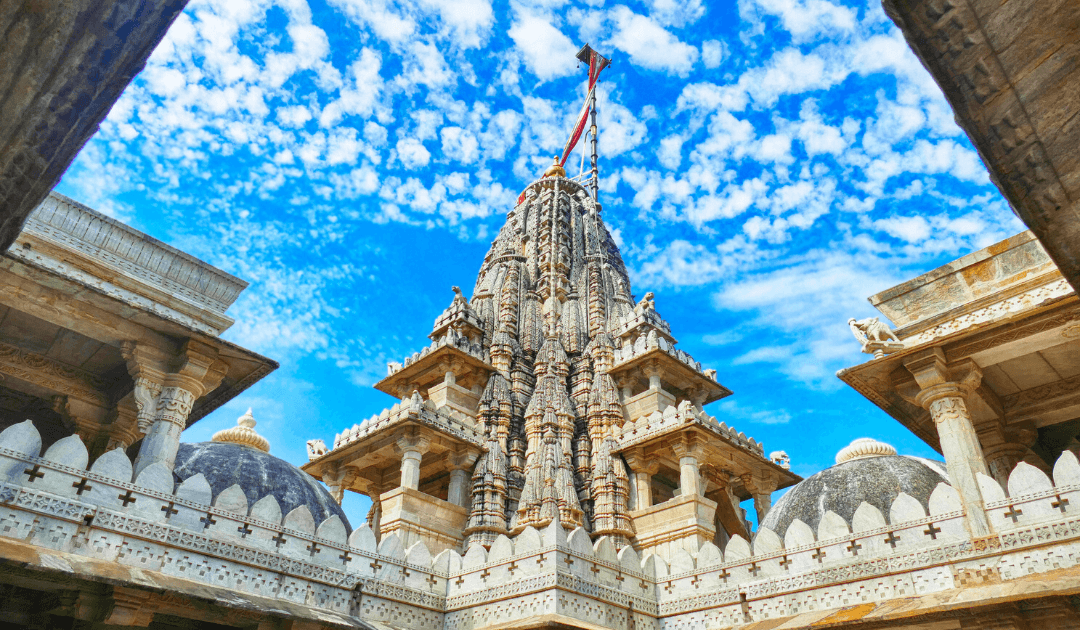Listen to this article (25:17 min)
This article was published exclusively online in the Christian Research Journal, Volume 47, number 02 (2024).
When you support the Journal, you join the team and help provide the resources at equip.org that minister to people worldwide. These resources include our ever-growing database of more than 2,000 articles, as well as our free Postmodern Realities podcast.
Another way you can support our online articles is by leaving us a tip. A tip is just a small amount, like $3, $5, or $10, which is the cost of a latte, lunch out, or coffee drink. To leave a tip, click here
Jainism is a religion with deep roots in Greater India. According to Jains, which are practitioners of Jainism, the religion has always existed. This would mean that it is as old as Hinduism itself, a religion that is often called sanatana dharma, or “the eternal religion,” due to its primordial history that predates written records. In theory, therefore, this would make Jainism older than Buddhism, which also emerged out of both Greater India and the Hindu religion. In fact, it is important to recognize that Jainism, Hinduism, and Buddhism are sibling religions (but not triplets since they were born at different times). When compared, these three religions share far more similarities in history, culture, belief, and practice than differences. In many ways, it may be more helpful to think of these as three different denominations within one older, prehistoric religion from which they each developed thousands of years ago. In olden days, they were hardly distinguishable, but over time their differences evolved and became more noticeable, eventually becoming recognized as separate religions.
THE TWENTY-FOUR FORDMAKERS
Because the Jain religion is believed by its followers to have existed since time immemorial, the vast majority of Jainism’s early history appeals more to legend than fact. And much of it revolves around twenty-four transcendent figures, the first twenty-three of which are shrouded in mystery. Collectively, these twenty-four figures are called tirthankaras, variously translated as “ford finders,” “fordmakers,” or “builders of the ford.”1 As a path through shallow water by which one can safely cross to the other side of a river, a ford symbolizes the path through which one transcends the relentless current of this worldly existence. In ancient India, fords represented a place where it was believed that deities descended, imbuing the place with spiritual significance. Fordmakers, such as Mahavira, were persons — later believed to be deities — who “made” or “built” a ford, usually in spectacular natural locations such as mountains, forests, and rivers.2 Through their deep spiritual wisdom, no doubt gleaned from lifetimes of karma, these fordmakers had learned “the way across the river of rebirth to the further shore of liberation [to] build a tirtha, or ‘ford,’ that others [could] use to make their way across as well.”3 Comparatively speaking, fordmakers paralleled bodhisattvas in Buddhism, who were spiritual masters that helped others attain nirvana while denying themselves this privilege until all others were given the opportunity to pass through. Over time, these fordmakers came to be called jinas, that is, “victors” or “conquerors.”4 Their victory was spiritual in nature, not physical. These fordmakers are represented in Jain temples throughout the world in statues and are essentially worshiped as gods.
THE LIFE OF MAHAVIRA
According to Jainism, the last fordmaker in our current life cycle was named Mahavira (“Great Hero”). There will not be another like him for thousands of years. As such, Mahavira serves as the foundational figure within Jainism. Though not the founder of the Jain religion, he is the preeminent forefather — much like Abraham within Judaism. However, unlike Judaism, in which there is only one eternal and personal God, Jainism makes room for various (temporary) deities; and, in fact, this is how fordmakers may manifest. Historically, for instance, Mahavira came to be understood as a god.
The exact dates surrounding Mahavira’s life vary, but it is believed that he was a contemporary of Buddha (whose given name was Siddhartha Gautama). Like Buddha, Mahavira lived approximately 2,500 years ago. Interestingly, there are many parallels between these two figures. For instance, both Mahavira and Buddha were born and raised in Greater India around the same time, and they were both from wealthy Hindu families of the same (warrior) upper caste. They both married beautiful princesses and fathered a child; they both renounced their privileged lifestyles; they both achieved enlightenment under a tree; they both formed disciples; and they both fathered a religious movement.5 In what today would be regarded as highly controversial in the West, Mahavira ended his life by practicing a ritual called sallekhana, or “holy death.” This is a ritual practice in which holy persons — based on complete clarity of thought and with a comprehensive mastery over their senses — starve themselves to death. Though generally regarded to be suicide by the Western tradition, the Indian tradition, in particular, Jainism, views holy death as a noble symbol of victory over attachment — a sort of martyrdom. It is when a holy person wholly embodies the core Jain principle of ahimsa (discussed below).
Mahavira’s Primary Teachings
Like Buddha, Mahavira was reacting against the dominant religious system of Hinduism. In essence, he rejected the historic gods of Hinduism (such as Vishnu and Shiva) and the worship of them (such as the worshiping ritual called puja). Mahavira rejected the scriptures of Hinduism (the Vedas), and he rejected the historic classification of Hindu society into different social types (the caste system). Despite such widespread rejection of Hindu principles, however, it is important to recognize that Mahavira also assumed and conceded many other cardinal Hindu beliefs, such as karma, enlightenment or liberation (moksha), and reincarnation.
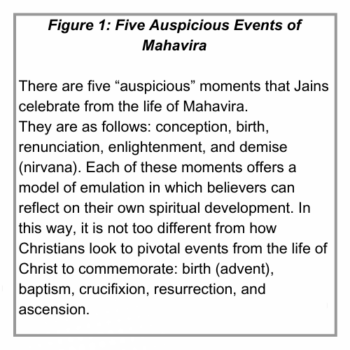
Mahavira’s teachings, much like Jesus’s, proceeded in oral form and were only recorded after his death. As often happens within new religious communities, there was division within Jainism that led to the emergence of two different groups — what we could call denominations. These denominations are called Digambaras and Svetambaras. While the former denomination clung more tightly to tradition and ancient practices, the latter denomination was more favorable to later cultural developments (further discussion below).
Jains today seek to imitate Mahavira’s heroic life. In other words, like Jesus in Christianity and Muhammad in Islam, Jains are encouraged to emulate the values of Mahavira and live a life that reflects what Mahavira stood for. Like Jesus and Buddha, Mahavira began his ministry at the age of thirty. But unlike Jesus, whose life was cut short only around three years after His ministry commenced, Mahavira taught and discipled for decades after his renunciation, eventually attaining nirvana at the age of seventy-two. Upon achieving nirvana, Mahavira escaped the cyclical chains of life and death and gained victory over karma. Although he was the latest fordmaker in our current life cycle, others like him will eventually appear when the time is right. But that will not likely be for thousands of years, which is why Mahavira proves central to the Jain religion.
JAINISM TODAY
Mahavira implemented four “fords,” originally known as tirthas, that continue to play a role in Jainism today. This includes four divisions of Jains: monks, nuns, laymen, and laywomen. Collectively, these four divisions represent the Jain community, what is called the sangha. In this way, it is not too different from medieval Roman Catholicism, in which the church was made up of clerics, monastics, and laypeople. Although the vast majority of attention within Jainism is focused on monks and nuns (again, much like medieval Catholicism emphasized those who took holy orders rather than everyday believers), most Jains are non-monastics, that is, laywomen and laymen. Practically speaking, this means that they cannot perfectly emulate the life of Mahavira since nirvana is simply unachievable for laypeople. According to Indian religious thought — to which Hinduism, Buddhism, and Jainism generally ascribe — the only individuals capable of enlightenment in this lifetime are those who have accumulated eons of karma sufficient to liberate themselves from this world. In other words, only monks and nuns would be capable of this, meaning that the life of most Jains is focused on attempting to live a good, honest, and ethical existence, while providing material support to monks and nuns who dedicate their days and nights to the achievement of enlightenment.
Although Jainism shares so much of its history, beliefs, and practices with Hinduism and Buddhism, it is a much smaller religion. Collectively, there are only around five to six million practicing Jains today. Most of them live in India, but even there, they represent less than one percent of the Indian population.6 Ironically, given that Mahavira — the religion’s most iconic hero — lived a life of renunciation, Jains in India have historically specialized in business and have, on the whole, done quite well for themselves and their families. In fact, on average, Jains are wealthier and better educated than both their Hindu and Muslim Indian counterparts.7 This financial advantage has enabled the lay Jain community to support the small but highly committed number of Jain monastics who have renounced the world in pursuit of enlightenment.
TWO HISTORIC DENOMINATIONS IN JAINISM
Whereas Christianity is generally divided into three major denominations or groups — Orthodox, Roman Catholic, and Protestant — Jainism is historically divided into two. As noted, the names for these two denominations are the Digambaras (“sky-clothed”) and Svetambaras (“white-clothed”). Both have laypeople and monastics, but historically the emphasis has been on the monastics. Although the two groups agree on many things — particularly what are called the five vows (listed in Figure 2 below) — there are also differences. The Digambaras represent a small portion of Jains. They get their name from their historic practice of going naked — just as Mahavira did upon renouncing his lavish lifestyle. (Female nun Digambaras do exist, but they wear clothes and, as a result, are believed to be “incapable of practicing non-attachment to the degree of which a man is capable.”8) Strange as it may sound, for Digambaras, “nudity remains the necessary condition for moksha [liberation].”9 In fact, the most rigorous of the Digambaras own no possessions at all and eat only what they can hold in their hands. They refrain from wearing clothes because they believe that clothes signify shame, attachment to this life, and even violence (since the fibers used were taken from living organisms, including plants). However, less rigorous Digambaras do wear clothes and participate in society.
The Svetambaras are less strict than the Digambaras. Unlike the most rigorous of the Digambaras — who wear no clothes — the Svetambaras have historically worn white clothes. Also unlike the Digambaras, the Svetambaras are more progressive in their views of female liberation. Specifically, they believe that women can achieve moksha in this life. Monks and nuns within the Svetambara denomination use a begging bowl and may wear a facemask and carry a whisk to keep from harming small or microscopic creatures (discussed more fully below under the concept of ahimsa). Most Jains today are part of the Svetambara denomination. For the most part, they are historically located in the northern and western parts of India.
RELIGIOUS WRITINGS
Like all other world religions, Jainism maintains a collection of holy writings that serve as the bedrock of its beliefs. The holy scriptures within Jainism are called agamas. There is disagreement between the two major denominations within Jainism as to the exact number of these scriptures. The agamas were written in a Prakrit language unrelated to Sanskrit, the traditional holy language of scripture in India. The agamas can be divided according to genre. For instance, there are rules for monks, philosophical teachings, doctrinal beliefs, and theological concepts. However, because there has not historically been consensus about the agamas within Jainism, a text written thousands of years later called the Tattvartha Sutra has become popular. Dating to the AD 300s or 400s,10 this philosophical text — written in Sanskrit — has come to serve as a compendium to many important Jain theological concepts.
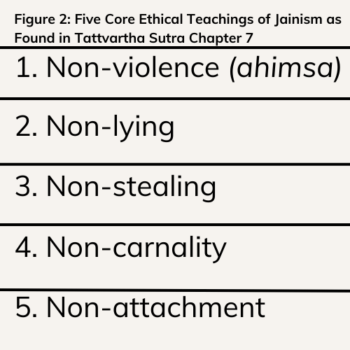
The Tattvartha Sutra begins as follows: “Right faith, right knowledge, and right conduct together constitute the path to liberation [moksha].” And it ends with directions for how to achieve enlightenment: “Omniscience or perfect knowledge [kevala jnana] is attained through destruction of delusion and destruction of knowledge-covering, perception-covering, and obstructive actions [karmas].” Once this happens, freedom from the endless cycle of birth and rebirth is achievable: “Owing to the absence of the cause of bondage [bandha] and with the functioning of dissociation of actions [karmas], the annihilation of all actions [karmas] is liberation [moksha].”11
Since the late twentieth century, the two Jain denominations have come to regard a scriptural writing called the Saman Suttam as representative of Jainism. This is effectively an integration of different Jain scriptures according to the two major denominations. Its status as scripture is, therefore, very recent, but over time it could become more essential to the Jain religion.
Beliefs
As mentioned above, there are many similarities between Jainism and its religious siblings of Hinduism and Buddhism. For starters, one of the foundational beliefs is a concept known as karma. Deriving from the Sanskrit word for “action,” karma is as universally accepted within the Indian religious context as gravity is in the Western scientific community. According to the Indian religious worldview, everything thought, said, and done generates karma that will return either positively or negatively. Within Jainism, in fact, karma takes on a physical force, meaning that one’s physical actions (in addition to mental intentions) can do either good or bad. Based on the universality of an impersonal force like karma, it becomes evident that Jainism has little role for a God or deity. As mentioned above, Mahavira rejected the Hindu gods of old and instead focused on individual liberation. Ironically, over time, Mahavira came to be recognized as a god — or, in some instances, a great hero — within the Jain religion. This also happened to Buddha, who also rejected the Hindu gods only later to be regarded as a god himself by his religious descendants.
In addition to karma, another important belief within Jainism is reincarnation and what is called samsara. This is shared among all major Indian religious traditions. As the Jain scriptures teach, “The mark of a substance is existence.”12 The soul of all living beings — whether flowers, rocks, humans, or animals — continue generation after generation. In contrast to the Abrahamic or monotheistic religions of Judaism, Christianity, and Islam, which believe life to be linear, temporal, and unrepeatable, Jainism understands life to be cyclical, eternal, and recurring.
This cyclical worldview is called samsara. All beings are trapped within this cycle lifetime after lifetime, unless liberation is realized. This liberation, called moksha, is achieved by eliminating karma. And karma is eliminated by following the three jewels of Jainism. These are right faith, right knowledge, and right conduct. First is right faith, which necessitates believing in the holy figures (called jinas or “ford builders” — and later coming to be recognized as gods) from the days of old who paved the way toward enlightenment. Second is right knowledge, which involves understanding what these historic figures actually taught. And third is right conduct, which entails behaving in a way that is consistent with the core teachings of the religion. Scholar of Jainism John Cort summarizes the three jewels as follows: “The Jain who wants to travel the path to liberation must have faith in the Jain worldview, must have knowledge of the details of that worldview, and must act properly in accordance with that worldview.”13 The individuals who follow this three-fold path can achieve moksha, or liberation from the shackles of samsara. But as mentioned above, this path is realistic for really only Jain monastics (monks and nuns), not ordinary Jain laypeople.
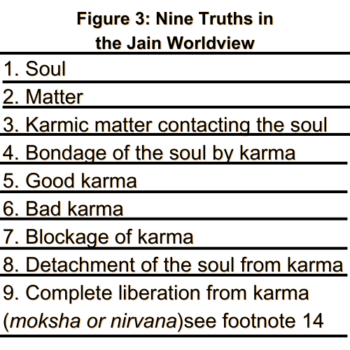
One last belief within Jainism that merits discussion is what is called ahimsa. It is variously translated as “non-violence,” “non-harm,” or “peace.” Because beliefs like karma, reincarnation, and enlightenment are equally shared among Hindus and Buddhists, it is perhaps safe to conclude that ahimsa is the primary distinguishing belief within Jainism. In fact, it is so important that even Mahatma Gandhi (1869–1948), though Hindu, adopted this Jain mindset as one of his most essential beliefs in his campaign against the British Empire. As Gandhi embodied in his peaceful protests against the British, ahimsa promotes nonviolence, but that is not the same thing as promoting inaction. As discussed above, karma always exists on earth; so, no action can ever be karma-less. It can either generate positivity or negativity. In this way, Jains believe that ahimsa generates positive karma and has the ability to eradicate negative karma.
Jains have historically exemplified ahimsa through the care they demonstrate when doing basic things like walking and breathing. Specifically, the most pious of Jains brush aside any living organisms that might be in their path, and they wear facemasks to keep from accidentally inhaling a microscopic bug. This, of course, is not the path of Jain laypeople, but it is not uncommon to witness among certain Jain monastics. More pointedly, however, is the illustration of ahimsa through starvation. As noted, this controversial practice is called sallekhana (or santhara). According to Jainism, virtually every jina, that is, fordmaker, fasted to death as a perfect embodiment of ahimsa. In many ways, fasting to death is the logical conclusion to the cardinal belief that our life is to be about nonviolence or non-harm. By fasting, Jain holy people demonstrate their compassion for all living things as well as their simultaneous detachment from all worldly things.
WORSHIP PRACTICES
Like Buddhism, which originally rejected the Hindu gods and focused on personal liberation before ultimately incorporating deities into worship, Jainism eventually adopted different gods into its religious experience. Generally speaking, Jain worship practices can be divided into three kinds: personal piety, corporate worship, and mendicant life.
When it comes to personal piety, this is typically done at home. It is similar to the worship ritual within Hinduism of puja, which can be performed in one’s house. Historically, Jains place a small shrine in their home depicting their preferred figures who have renounced the world. There are many to choose from, and most are simply referred to as gods or deities. However, these gods are not like the God of Christianity, whom Christians believe to be personal, all-powerful, and unrivaled. In Jainism, by contrast, gods are temporary and simply live in another realm; at some point in the future, they will be moved into a different realm. Though not existing eternally, these figures, or gods, are nonetheless cared for with great adoration and attention. As with Hindu gods, the images depicting these gods are ceremonially bathed, worshiped, and fed. In fact, the family altar centralizes family devotion each day around these figures, typically in the morning, with this traditional prayer called the Mahamantra:
I bow before the worthy ones.
I bow before the perfected ones.
I bow before the leaders of the Jain order.
I bow before the teachers of the Jain order.
I bow before all Jain monks in the world.15
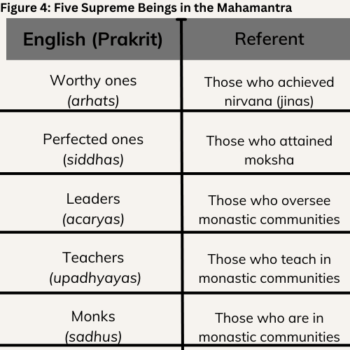
Corporate devotion occurs inside Jain temples, at pilgrim sites, and on specific holy days during festivals. In these Jain holy spaces, believers bow before, gaze at, and pray to the images of the jinas displayed. These images offer a physical depiction of a spiritual being. Each Jain temple may have a different number of jinas depicted, but usually there is a primary one. This is similar to Hinduism, and, in fact, in the United States, it is not uncommon for Hindu temples to share space with Jain temples. However, there are not clerics or ordained clergy as in Christianity. The prayers offered to the gods are similar to the prayers offered by people in other religions. Jains pray for health, prosperity, safety, and so on. But not all Jains worship gods. Some tend to focus on living teachers, such as gurus, who are able to offer sage advice and give blessings to their followers.
A final type of worship within Jainism has to do with mendicant communities. These are monks and nuns, and they have received a disproportionately large amount of attention among religious scholars at the expense of Jain laypeople.16 Jain monastics abide by five vows, and their daily lives are quite different from laypeople. As mendicants, they beg for their food. This also entails owning no possessions, refraining from any sexual activity, performing daily rituals and worship practices, and generally living separate from all worldly things. These monks and nuns commonly practice meditation. For instance, one daily meditation practice is called Samayika, and it is designed to last twice the number of the fordmakers, that is, forty-eight minutes. As with Buddhism, the purpose of Jain meditation is to cultivate one’s true identity. It is supposed to disentangle a person from the attachments of the world. It is not altogether different from another Eastern concept called equanimity, which entails being so conscious of one’s impermanence that one is completely aware, completely steadfast, and completely serene.
Critique of Jainism from a Christian Perspective
With its emphasis on ahimsa, reincarnation, and moksha, Jainism presents a worldview that contrasts sharply with Christian beliefs. From a biblical perspective, Jainism’s rejection of a personal creator God and its reliance on individual effort for salvation deviates from the Christian doctrine of redemption through faith in Jesus Christ. Additionally, while both religious traditions establish an ethical framework for living, Jainism’s strict adherence to ahimsa raises questions about the practicality of its ethical framework in a fallen world, and its undue dependence on human nature rather than divine mercy falls far short of genuine grace. Ultimately, Christianity offers a path to salvation through the sacrificial atonement of Jesus, lifting us up out of the brokenness of our lives, which contrasts greatly with Jainism’s reliance on human striving for spiritual liberation.
Derek Cooper (PhD) is managing director of Thomas Institute, an educational travel company that specializes in learning on location. He is the author of fifteen books, including Christianity and New Religious Movements: An Introduction to the World’s Newest Faiths (Phillipsburg, NJ: P&R Publishing, 2023), from which this article is partially adapted.
NOTES
- Agustin Panikar, Jainism: History, Society, Philosophy, and Practice (Delhi: Motilal Banarsidass Publishers, 2010), 30.
- Panikar, Jainism, 30.
- Jeffrey Long, Jainism: An Introduction (London: I. B. Tauris, 2009), 3.
- Helmuth von Glasenapp, Jainism: An Indian Religion of Salvation (Delhi: Motilal Banarsidass Publishers, 1999), 274.
- This history comes from the Kalpa Sutra, the Jain scriptures focused on the life and miracles of Mahavira.
- Dyron Daughrity, More Than One: An Introduction to World Religions (Abilene: Abilene Christian University Press, 2022), 87.
- Lawrence Babb, Understanding Jainism (Edinburgh: Dunedin Academic Press, 2015), xiii.
- Long, Jainism, 17.
- Padmanabh Jaini, The Jaina Path of Purification (Berkely: University of California Press, 1979), 20.
- Babb, Understanding Jainism, 29.
- Tattvartha Sutra 1.1, 10.1, and 10.2, respectively.
- Tattvartha Sutra 5.29.
- John Cort, Jains in the World: Religious Values and Ideology in India (New York: Oxford University Press, 2001), 18.
- Uttaradhyayana Sutra 28.14.
- Mantras like this are common in Indian religions.
- Their numbers are only in the thousands. And they are found, really, only in India. For more, see Babb, Understanding Jainism, 65.
